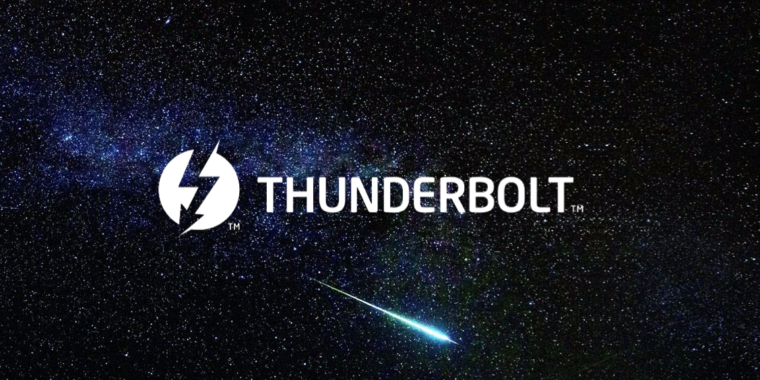Intel details Thunderbolt 4: Required DMA protection, longer cables, and more

-
The branding for Thunderbolt 4.
-
A render of the 8000-series controller chips for Thunderbolt 4.
-
Here’s a chart from Intel’s press deck showing how Thunderbolt 4 differs from Thunderbolt 3.
-
And here’s a list of what’s new, from Intel’s press deck.
-
Thunderbolt 4 accessory families, from Intel’s press deck.
-
Thunderbolt 4 accessory configurations, from Intel’s press deck.
Intel has outlined what to expect from the new Thunderbolt 4 standard, which is expected to start appearing in consumer devices later this year.
While it won’t offer an increase over the 40GB/s that Thunderbolt 3 does, Thunderbolt 4 has steeper minimum requirements than Thunderbolt 3 for devices to claim certification—and that makes some new features and perks standard.
These are the specifications for Thunderbolt 4, according to Intel:
- Double the minimum video and data requirements of Thunderbolt 3
- Video: Support for two 4K displays or one 8K display.
- Data: PCIe at 32 Gbps for storage speeds up to 3,000 MBps.
- Accessories with four Thunderbolt 4 ports
- Universal 40GB/s cables up to 2 meters in length
- Required PC charging on at least one computer port.
- Required PC wake from sleep when computer is connected to a Thunderbolt dock
- Required Intel VT-d-based direct memory access (DMA) protection
- USB4 specification compliant
Thunderbolt 4 will be compatible with all USB and Thunderbolt 3 connections, including USB4—and it will use the USB-C cable standard. It will debut in laptops equipped with Tiger Lake CPUs launching later in 2020, and Intel will offer 8000-series controller chips (Maple Ridge JHL8340 and JHL8540) for computer makers, plus the Goshen Ridge JHL8440 controller for peripherals.
We should also note that Thunderbolt 3 and 4 devices will share the same, numberless branding (simply “Thunderbolt”), so telling the difference between the two at a glance won’t be easy.
Mac users are going to walk away from this news with some unanswered questions, unfortunately. We haven’t seen anything to indicate whether or how Apple Silicon Macs—which are expected to start launching later this year as well—will have Thunderbolt 4 ports.
The specification and rollout as described seem to preclude Thunderbolt 4 certification for computers that don’t have Intel CPUs, but we’re going to have to wait and see how this all shakes out.
Listing image by Intel
https://arstechnica.com/?p=1690216